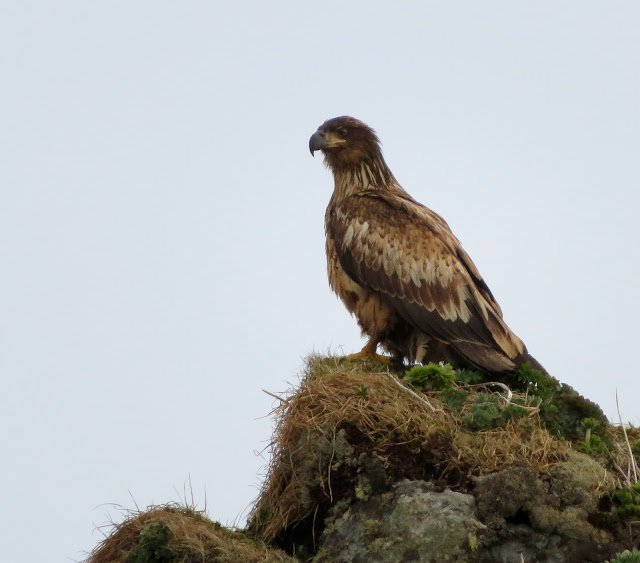The islands are a punishing land, but a place of abundance. They are a major breeding ground for seabirds who nest on steep cliffs and rely on the rich marine environment for food. During the summer months, the archipelago becomes a vital stop for migratory species traveling between North America and Asia. The Aleutian cackling goose is an endemic subspecies of the Canada goose, notable for its smaller size and adapted to the harsh world of the Aleutians. Raptors including peregrine falcons, eagles, and hawks also call these windswept rocks home. The islands are affected by introduced species including cattle, caribou, foxes, and rats: the ecosystems and animals are visibly different on islands with introduced mammals.

Aboard the C/V Miss Alyssa on the passage from Dutch Harbor to a project on Unalga Island, we encountered something unusual for the Aleutians: blue skies, light winds and calm seas. Dutch Harbor averages 80 inches of rain, 250 rainy days, and 150 days of fog per year. Meanwhile, powerful Pacific storms batter the islands throughout the year with gale-force winds, typhoons, and dangerous storm surges.

With the exception of some stunted willows, the vast majority of the chain is devoid of native trees. On some of the islands, there are a few coniferous trees left over from the Russians. Aleutian conifers, some up to two hundred years old, rarely reach even 10 feet tall because the winds here like to snap off anything taller.

Tide rips in the Aleutians are a ferocious force, resulting from the collision of currents, tides, and underwater geography as water sloshes between the Pacific and the Bering. These violent, swirling, and dangerous currents are vital to the region's marine ecosystem, helping to concentrate nutrients that support a diverse array of wildlife.

It takes about five years for a bald eagle to mature from a small, gray three-ounce hatchling to a three-foot adult with a six-foot wingspan. During years two and three, the eagle is referred to as immature. At two and a half years, the most varied plumage occurs. The breast remains dark brown, the legs are a brighter yellow, while the eyes and beak continue to lighten. Immature bald eagles look a bit like they are having a bad hair day.

Marookas are like rubber-tracked dump trucks that are purpose built for soft or uneven terrain while minimizing ground impact - they're ideal for the challenging mud and rough landscapes of the Aleutians. Compact and durable, they can navigate confined spaces and operate reliably in extreme conditions.

Part of the Pacific Ring of Fire, the Aleutians are home to over 50 active volcanoes, making it one of the most volcanically dynamic areas on Earth. These volcanoes were formed by the subduction of the Pacific Plate beneath the North American Plate, creating a chain of stratovolcanoes and shield volcanoes. Their eruptions vary from explosive, ash-laden events to lava flows. For the indigenous Unangax̂ people, the volcanoes are woven into cultural and spiritual traditions, representing both creation and destruction in their homeland. For contaminated site cleanup crews, the Aleutian volcanic ash mixes with the endless rain to form muck that even Marookas can't beat.


No comments:
Post a Comment